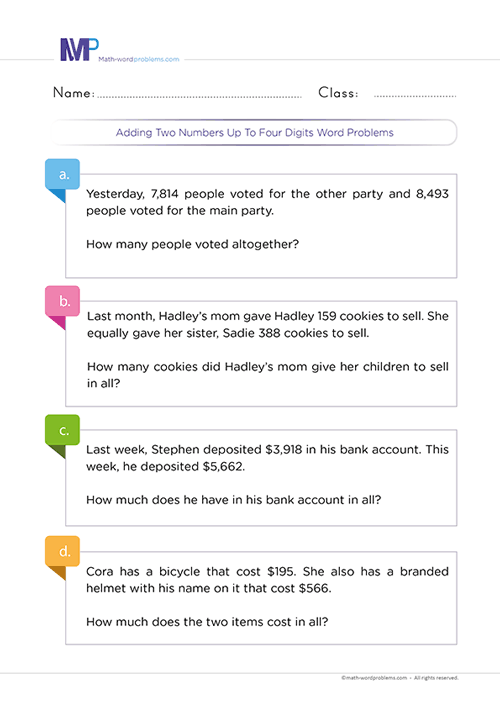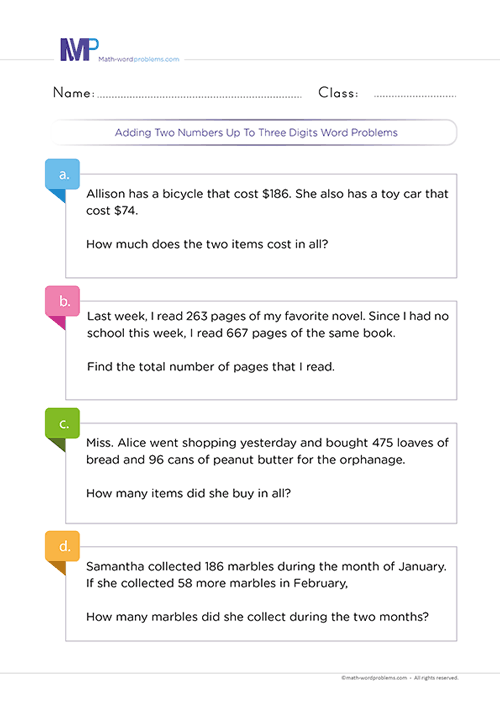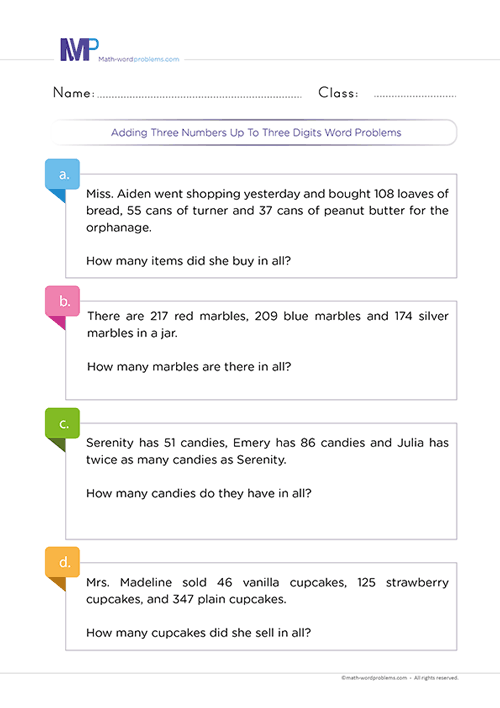 How to add two numbers up to four digits word problems
How to add two numbers up to four digits word problems

- INTRODUCTION
- Step 1 Identify
- Step 2 STRATEGIZE
- Step 3 SET UP
- Step 4 PROVIDE A SOLUTION
- Step 5 CHECK YOUR WORK
Get more contents on this skill...
This unique Grade 2 resource on how to add two numbers up to four digits word problems consists of a step-by-step solving guide to provide kids with basic skills and strategies for solving both simple and challenging addition word problems.
Also, we will illustrate the best methods on how kids can read and understand addition word problems perfectly, other than procedural knowledge or rule-driven maths calculations.
Hence, they will learn how to add two numbers up to four digits word problems, especially those involving indirect language, irrelevant information, and multi-step problems.
Unique steps on how to add two numbers up to four digits word problems
Here are unique steps on how to add two numbers up to four digits word problems. These captivating steps to add two numbers up to four digits focus on the maths computation and emphasize higher-order skills such as reasoning and problem-solving in your kids.
This emphasis has significant implications for learners' problem-solving skills on how to add two numbers up to four digits word problems in that they will interpret and formulate solvable equations efficiently.
In addition to this, and for practice purposes, we have added real-life examples for you to see how well these steps work.
Step 1 IDENTIFY THE PROBLEM:
To identify the problem,
- First, you must read the problem between the lines to understand.
- Next, identify and underline relational statements.
- Now, reread the problem and try to sort out essential numbers and keywords in the problem.
As for keywords, here are some common keywords that you will see when you come across addition word problems, namely:- add, plus, more, total, increase, together/all together, combined, sum, grow, join, both, in all, altogether, how many in all, how much, and, etc.
Note: learners should understand that it would be best not to rely entirely on keywords alone because a particular keyword can have different meanings in different word problems.
In that case, you need to read the question very well to understand the situation the word problem describes. After reading, you will also find out if the problem makes sense first before determining which operation you need to use.
Step 2 STRATEGIZE AND DETERMINE THE OPERATIONS
Now, ask yourself, “How will I solve this problem?”
In this step, you will apply the read-to-understand rule. You must read the word problem and try to interpret it in your own words.
Also, since each word problem may require a different way to solve it, the key points below will enable your little ones to tackle any word problem irrespective of the way the problem is.
- First, the keyword(s) in the word problem will help clarify the operation you need to carry out.
- However, as mentioned above, using keywords alone to solve word problems has some limits.
- So, you must first read the word problem to understand the situation that the problem is describing.
- Reading the problem to understand it will enable you to identify the problem type and relational statement, which, together with the keyword(s) in the problem, will determine the accurate math operation that you need to use
Step 3 SET UP A NUMBER SENTENCE AND AN EQUATION
- Now, after knowing which operation you will perform from step 2 above, form short phrases to represent the information given in the word problem.
- These short phrases or sentences represent the vital information that makes it easier to solve the word problem. In order words, it is like a diagram of the word problem.
- Then, you can deduce a solvable maths equation to represent the information given in the phrases you constructed above.
Step 4SOLVE THE SOLUTION
Next, after writing down the maths equation, you can solve the problem using any addition method of your choice, preferably the column method. Furthermore, always add the unit of measurement to the final result.
Step 5 VERIFY YOUR ANSWER
Finally, check your work to make sure that your answer is correct. For instance, since you are dealing with only numbers and not algebraic expressions, it is good to use reasonableness by estimation to see if your answer makes sense.
So, if you estimate and the answer is close to what you have, then it is correct. However, if your answer is outrageous, you must go back to step one and start over again.
Examples of how to add two numbers up to four digits word problems
Example One
Step 1: First, read the problem and underline all the relational statements. After doing this, you will find out that the important numbers in the problem are 147 and 2,016. Also, the keyword in the word problem is “added.”
Step 2: Next, ask yourself, “How can I solve this problem?”
So, what is the problem trying to say?
The problem is that Tina’s mother gave her a certain number of pearls as her birthday gift. The problem is also trying to tell you that Tina already has a certain number of pearls somewhere. Now the problem goes further to explain that Tina took the pearls her mother gave her and added them to the ones she already has.
The problem wants you to find the number of pearls she has now after adding the ones her mother gave her to the ones she already has.
Now, the question should be:- which operation can join two similar things into one?
So you see, from the situation that the problem is describing, from interpreting the problem in your own words and the keyword “added” found in the word problem calls for an addition operation.
Step 3: Now, construct short phrases representing the most vital information in the word problem.
Next, write down a solvable maths equation to represent the information given in the sentence that is in bold below.
- Number of pearls her mother gave her = 147
- Number of pearls she already has = 2,016
- Therefore, the total number of pearls she has now = the number of pearls she already has + the number of pearls her mother gave her.
→ 2,016 + 147 = ?
Step 4: Finally, from step 3 above, stack the values in the equation you formed so that their place values should line up. Then, add the values using the addition method, preferably column addition. It is equally important to always include the unit of measurement in the final result.
So, Tina has 2,163 pearls now
Step 5:Finally, check your work to ensure your answer is correct. Since you are dealing with only numbers and not algebraic expressions, it is good to use reasonableness by estimation to see if your answer makes sense.
So, if you estimate and the answer is close to the one you have, then your answer is correct. However, if your answer is outrageous, you must go back to step one and start again.
Example Two
Step 1: First, read the problem and underline all the relational statements. After doing this, you will find that the important numbers in the problem are 7,452 and 9,123. Also, the keyword in the word problem is “altogether.”
Step 2:Next, ask yourself, “How can I solve this problem?”
Now, try to interpret the problem in your own words.
As you can see, the problem is that two parties were having an election yesterday. A certain number of people voted for the main party, and a certain number voted for the other party.
Now, the problem needs you to find the fraction of the pizza; he did not add cheese on.
Now the problem wants to know the number of people that voted combined.
So, the question you should be asking yourself after interpreting the problem is: - which operation can I use to combine two similar things as one?
In the problem, the part is the number of pieces of pizza he did not add cheese, and the whole is the number of pieces he divided the pizza into.
To answer the question above, you see that from the situation that the problem is describing, from interpreting the problem in your own words, and the keyword “altogether” found in the word problem calls for an addition operation.
Step 3:After that, you can form short phrases representing the most vital information in the word problem.
Furthermore, write down a solvable maths equation to represent the information given in the sentence that is in bold below.
- Number of people that voted for the other party = 7,452
- Number of people that voted for the main party = 9,123
- Therefore, the number of people that voted altogether = the number of people that voted for the other party + the number of people that voted for the main party.
7,452 + 9,123 = ?
Step 4: From step 3 above, stack the values in the equation you formed so that their place values should line up. Then, add the values using any addition method, preferably column addition. Also, always include the unit of measurement to the final result.
So, 16,575people voted altogethe
Step 5: Finally, check your work to ensure your answer is correct. Since you are dealing with only numbers and not algebraic expressions, it is good to use reasonableness by estimation to see if your answer makes sense.
So, if you estimate and the answer is close to the one you have, then your answer is correct. However, if your answer is beyond reasonable limits, you must go back to step one and start again.





